Snow Wells
What do you picture when you think of Spain?
Sunshine sparkling on a blue sea. Sandy beaches fringed by a never-ending border of hideous apartment blocks. Red wine; orange groves; bull rings; flamenco dancers… If you have visited the interior you will also picture villages nestling on rocky outcrops, and mountain ranges fading into the blue. If you have come here for the skiing you might picture crisp white slopes – or, then again, you might picture brown ones, on which the snow machines have tried to paint white stripes.
Whatever you associate, in your mind’s eye, with Spain, one thing that you are not likely to picture is a thriving ice-making industry… but two hundred years ago, in the parched, sun-baked southern region, there was just such an industry, and people were getting rich making other people a little bit cooler.
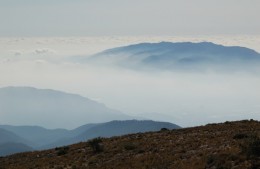
Dotted about on the higher slopes of the Sierra Espuña and in various other mountain ranges are a number of curious round constructions. Most are no longer fit to be described as buildings; most consist merely of a stone-built circle some fifty feet across and almost as deep. The local people call these structures “los pozos de las nieves” – and that is exactly what they are; they are snow wells. When the older folk were children the pozos (poe-thoes) still had roofs, and not so very long before that the buildings were still in use.
I first heard about the pozos back in December, and I would dearly have liked to go rushing off at once, into the mountains, to see them surrounded by snow. However, there is not much snow nowadays – and, anyway, there was not much time to spare.
In the event, it was the middle of July before we finally managed to fit in a visit to the pozos. With the sun glaring down at us from an intensely blue sky we toiled up towards the summit, first in our old banger and then on hoof. The temperature in the valley was 43° C (110°F) but up here, at 1300m (4,000 ft) the heat was a little less oppressive.
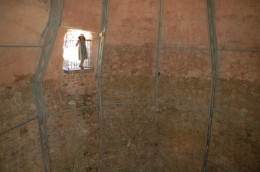
On the north facing slope of the highest peak in the Sierra Espuña we followed a well-trodden trail which soon brought us to half a dozen snow-wells, two of which had been re-roofed. Sweat trickling down our limbs, we peered inside one of these reconstructions, into a dark, deep pit which, one hundred years ago, in this same month, would have been half-filled with ice…
No, the summers were not so very much cooler back then.
So, what was it all about, then, this ice-making industry? However did they do it?
And more to the point, why did they do it?
Let us start with the how.
As everybody knows full well, the climate, here on Earth, is somewhat variable. The scientists tell us that tens of millions of years ago the place used to be scorchingly hot. And before that, for millions of years it was insufferably cold. Man didn’t have to endure any of this. He only showed up about five million years ago, and during his time the climate has been wobbling to and fro and bouncing up and down like a yo-yo. During this modern era our planet has seen a number of ice ages, the most recent of which was a thing of the past some ten thousand years ago. Since this time the place has been gradually warming up – but not consistently. During the warming there have been a number of cold spells which are known to us as mini ice ages. The most recent of these mini ice ages was in the 1800s. The one before that kept Henry VIII and his court wearing fur coats all throughout the summer. So far as I am aware there is no record of Henry having liked ice-lollies, but perhaps his Spanish counterpart and the father of his Spanish-born wife enjoyed such luxuries. In any event, records show that there were certainly snow wells in the Sierra Espuña at the time of the Spanish Armada (during the reign of Henry’s daughter, Elizabeth). Their hey-day, however, was in the more recent cold snap.
Ice-making was not a uniquely Spanish thing. Back in the 1800s, our northern European ancestors and our cousins in North America used to harvest the ice which formed every winter on the ponds and lakes. They used to wait until it was good and thick, and then they walked out onto the ice, drilled a hole through it, and cut it into blocks using a saw. In some places, the ice blocks were packed into dome-shaped buildings which were much smaller but not dissimilar to the Spanish snow-wells. In others they were simply piled up, with layers of sawdust or grass to keep them from becoming one unit, and were then covered all over in a thick, insulating thatch. Accounts of such ice-making exploits can be found in Laura Ingalls Wilder’s biographical story, Farm Boy, and in Henry David Thoreau’s book, Walden. According to Thoreau, the ice gathered in one winter might still be frozen when the next one came along. This is surprising – although, bearing in mind the climate in northern North America, it is not actually astounding. But ice-making in the most arid, parched, sun-baked corner of Europe… that, one feels, would be a different matter altogether.
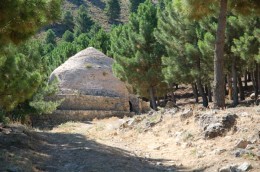
In Spain they made their ice by simply gathering up the snow and packing it down into the bottom of the pozos. It sounds delightfully simple, and I suppose it was – particularly when compared to the pond method. When the snows arrived on the high mountain tops, hundreds of peasant workers would be recruited and would make their way up from the nearby villages. For the next few weeks and months they would live up here, in stone-built dormitories, and would spend their days making snowmen…
Well, alright; not snowmen as such. But they would spend their days making balls of snow of the sort that children make when they are constructing a man. A rolling stone gathers no moss, but a rolling ball of snow gathers plenty more snow, and so the workers would wander about, pushing along their snowballs. If the snow is deep it takes only a few minutes to create a ball which is too heavy to push – and so, every few minutes, the men would roll their balls towards the wells, along specially cleared runs, and would send them plummeting down into the pit.
As the hours and the days went by the plummet became a mere hop, and then there was no drop at all, but it took a lot of snow to achieve this end, because all the while that the men were wandering about in the woods, two or three of their colleagues were stamping and hammering on the snow, shovelling it around with wooden spades and packing it down with hefty wooden mallets, to turn it into ice. The harder the snow was packed, the better the quality of the ice, and the longer it would last. Perhaps the character of the snow also helped. At any rate, ice from the Sierra de Espuña was reckoned to be of the very best quality, being absolutely transparent.
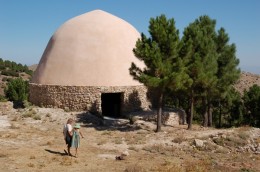
The labour of making ice was seasonal, of course, but although the greater part of the work-force saw only temporary recruitment a handful of men were employed on a full time basis. Their work did not stop when the pozos were full, nor even after they were empty. No sooner were the snow-wells empty, at the end of September, than they had to be cleaned. The dormitories had to patched up, and firewood gathered in preparation for the coming winter. The snow fields had to be cleared of fallen branches and such like, so that the snow brought in would be perfectly clean and free of debris; for, after all, nobody wants to find pine needles or squirrel dung in their G and T.
When the first snows arrived, in November or December, the labourers would ascend from the surrounding villages. They were divided into teams, each with responsibility for a different “raso”, or snow-field, and one from each team was appointed to take a turn at packing down the ice. This chore was not one which the men relished. The architects who designed the pozos were evidently right in their calculations, for the climate within was very much colder even than that on the icy, wind-swept slopes. Although he was working hard with his spade and mallet, after a brief stint as a “neveraro” the worker would be chilled to the bone, and so the job was rotated.
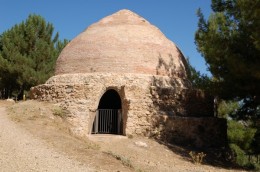
Come May, the order of work was reversed, and the employees began the business of un-packing the well. In order that the ice should not form itself into one giant-sized cocktail cube it had been set down in layers about two feet (or 60cm) thick, each layer being divided from the one above by a covering of esparto grass. Nevertheless, the workers still had to cut the huge disc into manageable pieces.
Clearly, the bigger the piece of ice, the longer it takes to melt, and so the ideal size for a lump of ice was the biggest one that could be lifted by two men and humped about by a mule. It measured roughly two feet, by two, by one foot (60 x 60 x 30cm), and after it had been hacked out it was wrapped in esparto grass and sacking and was hurried on its way.
On its way to where?
On its way to the city.
Half of the pozos which we visited served the city of Murcia, and the others, standing roughly half a mile away, served Cartagena. Murcia is relatively nearby, but the distance between the Sierra Espuña and Cartagena is almost 75 kilometres (53 miles). This was the absolute maximum distance that ice might be transported, for it took whole day for the men and their mules to cover this route – or rather, it took a whole night, because that is when the business of carting the ice was conducted – in the relative cool of the night. Even with this advantage, it is said that somewhere between a third and a half of the ice block had melted away by the time it reached its destination.
Who bore the loss, one wonders?
Seemingly it was the factories which lost out, because records show that the buyer paid for his ice by the kilo.
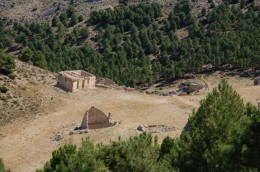
That brings us back to the matter of why. Why go to all this trouble to make ice?
Were the people using it to preserve their food?
No, that would have been a silly idea. In the centuries before the invention of reliable gas and electric refrigerators food was preserved by salting and bottling and by careful management of plant and animal resources. For an individual or a business to have switched to dependence upon a means and a substance which was not perfectly reliable might have spelt personal or economic disaster.
Incredible though it may seem, our great-great grandfathers were making ice and carting it around the countryside purely for the purpose of cooling their drinks!
Naturally, not everyone could afford to put ice in his sangria or his cognac – but as the fashion took off, anyone who was anyone wanted to. Soon it became all the rage to have an ice box in your mansion; and there were plenty of mansions in Cartagena at this time, because this craze coincided with the mining boom in the adjacent Sierra Minera.
Whilst some folk derided the new fixation with cold drinks, calling it a vice, many more praised it as being beneficial to the health. Iced drinks cooled the brain; they relieved the sufferings brought about by the summer’s heat and aridity. More specifically, iced water was particularly and obviously useful for the treatment of anyone suffering from a fever. Thus it was that the municipalities, too, began to invest in ice boxes – or “neverías” (from nieve, meaning snow) – and to buy ice for use in the hospitals.
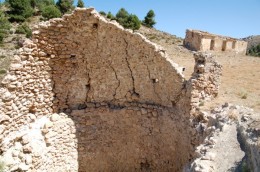
The snow-wells are very attractive buildings which suit their surroundings. To an extent, this was inevitable because, of course, they were built from the rock on which they stand. However, for the men who owned them the picturesque appearance of the pozos was a mere coincidence and a triviality. These are industrial buildings, constructed exclusively for the purpose of financial enrichment, and every aspect of their form is expressly designed for the maximum advantage.
The dome-shaped roofs were strong, and shed the snows which might have broken a pitched roof – but that was not their only purpose: the wise men of the time believed that a dome shaped roof, punctuated at ground level by three small doorways, encouraged the wind to whistle through the ice-packed building and keep things cool. Thus, the space between the top layer of ice and the roof was not packed with grass, or other insulating material, and nor were the doorways ever closed, even in the middle of summer.
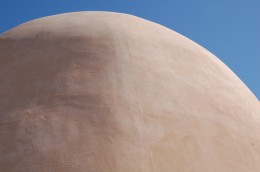
The outside of the roof was covered all over in sparkling pinkish-white plaster, made from the surrounding stone, and whereas a tiled roof soaks up the summer’s heat, this covering served to reflect the sun.
The greater part of the building is sunk out of sight, below the ground, – and, again, this was not because of concerns regarding its visual impact but because this means of construction affords the best insulation. The well is lined with stone, not because stone is attractive but because some sort of lining was needed, and the stone came readily to hand.
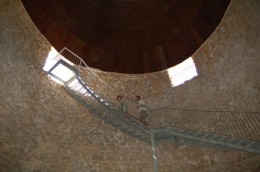
Set against the rounded wall of each pozo there was a spiralling stone staircase. Now, the staircases have fallen down, but one of the newly restored pozos has been fitted with an iron staircase. Standing at the bottom of the well, on the stone floor, I felt that this circular room, with its lofty domed roof had a very modern feel. The staircase on the wall seemed rather trendy – but once again, it was purely functional. How else would the workers ascend as the level of the snow rose? How else build a staircase which would not occupy space in this “silo”?
So, too, the well-made floor is functional: drainage was very important – because, inevitably, some of the ice would melt – and so the floor had to be constructed in such a way that the water would seep away.
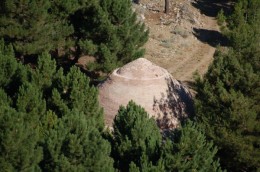
In short, every aspect of the pozos was determined according to the laws of financial reason. Even their situation was critical. For a start, they needed to be built in well-drained ground. Secondly – and for rather obvious reasons – they ought to be placed in the shade. Thirdly, they must stand at the highest, coldest point in the mountains – but not on the very ridge; if they were on the ridge the men would have had to push their snowballs up hill. The snow-fields appertaining to each set of pozos lay on either side and above them.
Like all fashions, ice-making was a profitable business. According to the records, in 1794 the city of Murcia alone bought 450,000 kilos of ice (which suggests, incidentally, that the 8 pozos serving her must actually have made somewhere around 700,000 kilos). Clearly, in the 18th and 19th centuries ice was a great luxury and must have been a very expensive commodity. Clearly, it must have cost much more, in relative terms, than it costs now. Unfortunately, I have not been able to discover what it was actually worth, but if we will assume that it cost the same as it costs today, in the supermarket, that particular season’s harvest would have fetched the owner of the Murcian pozos 675,000 Euros (or roughly half a million pounds). This figure may be wildly inaccurate – but even so, it is plain that ice-making was very big business. No doubt the owners of the pozos lobbied hard to ensure that the municipalities bought ice from their own, and no other source; no doubt they offered as many bribes as today’s sharp business men. And no doubt the mayor and his cronies were always well catered for….
Standing beside the broken down pozos, with the sun searing our limbs, we found it hard to picture the activity which once took place on this tranquil, unspoilt slope. Hard enough, it was, to imagine the hillside thigh deep in snow. Hard enough, as we stood there baking, to imagine men in full-cloth coats shaking the wetness out of their rabbit-skin mittens and wrapping the scarves more tightly around their red noses. Yet, although the hillside is so little changed, it was harder still to picture this place as a centre of commerce and industry and the fountain of somebody’s wealth. One hundred years ago beneath this same sweltering sun, those peasant workers, dressed now in open-necked shirts, were preparing to cut a new layer of ice and make the nightly run down to Cartagena.
In a hundred years from now will the industrial and commercial wasteland around that same city be so tranquil and appealing?
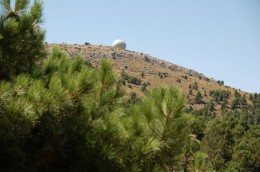
Of the 38 “pozos de la nieve” remaining within the region of Murcia, 26 are to be found in the Sierra Espuña and 8 are highly accessible, being within easy walking distance of a car-park. To reach them, head for the town of Totana, on the main drag between Murcia and Lorca. From here, take the MU502, drive past the scenic village of Aledo, with its ancient castle, and turn right along the road sign-posted Parque Sierra Espuña. Then just keep on driving up the hill, turning left at the only junction, until you eventually arrive at a small car-park, which is on your right. If you overshoot the car-park you will shortly thereafter arrive at the top of the hill and will find yourself confronted by a sign which says Strictly No Admittance to the Military Base… in which case, just turn tail very quickly – and the car-park is now on your left.
Besides the pozos photographed here there are numerous others which served other towns and villages, including nearby Lorca. These are all rather further along the trail and, so far as I am aware, have not been restored. I am told that to follow the entire trail and visit all 26 pozos would take two days.
I am hoping, in the near future, to find the time to make some reconstruction drawings and paintings of the pozos de las nieves. If anybody is interested in the idea, please drop me a line.

They’re not on the same scale, but many estates had ice houses in the past. The nearest I know of is at Bognor.
The BR history page has this, with a digram showing a cross section.
[Note : Long excerpt from Bognor Local History website removed for copyright reasons. The original article can be found at http://www.bognor-local-history.co.uk/article36.html. –Caesar]
Thanks for the link. As you say, many grand estates in England had ice houses and some even had special ponds, created for the harvesting of the ice. The distinctive thing about the Spanish snow wells is that they are very much bigger. They are also very remote from the towns whose inhabitants they served. For me, however, the most intriguing thing is the idea of anyone managing to make and preserve ice in a country which has such a hot summer.
I have been doing a little bit more reading on this fascinating subject, and I have now discovered that there was also an ice-making industry in New England, one of the most northerly states in the USA. Besides making ice for local consumption, the manufacturers also shipped it to the southern states and to the Caribbean!
Of course, the ice-making business in the USA was nowhere near so old as the one in Spain – and, as it turns out, even these “pozos” are relatively modern. I have now learnt that man was harvesting ice and preserving it in Iraq, of all places, in 1700 BC! Presumably these snow houses must have been run along the same lines as the Spanish ones, with the ice being made up in the mountains and carried down as and when the king wanted to hold a party…
It is said that Alexander the Great also had ice houses built, and there were ice houses in Rome during the third century AD. There’s really nothing new under the sun!
hie
that is a very interesting piece you have written there. do you know if there is a booklet or website where i can find the trail of the 26 pozos. also any other info on pozos and there whereabouts, any region?
thank you
sharon
Hi Sharon,
There is a book about the pozos. It’s in Spanish. It’s called Los pozos de nieve de Sierra Espuña: (el comercio de la nieve en el Reino de Murcia, siglos XVI-XX), by Ginés Rosa, ISBN 9788460744818. I don’t know where you can buy it… There is some info about the book at http://www.totana.com/cgi-bin/pozos.asp.
There is a certain amount of information online too – search for “Pozos de Nieve Sierra Espuna”.
I hope this is helpful.